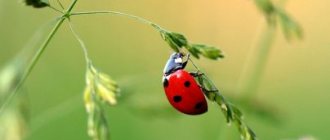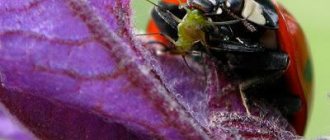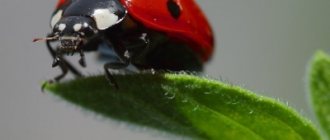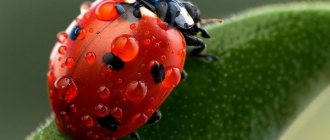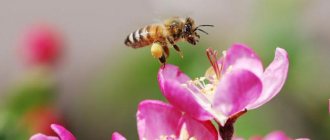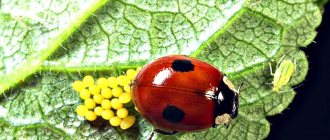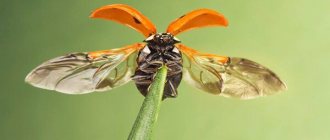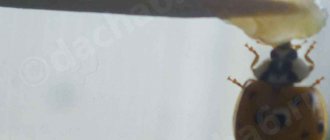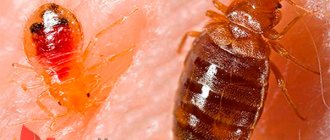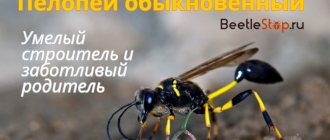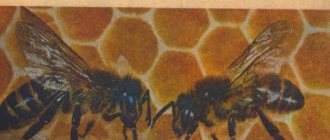The ladybug is a beneficial insect, one of the few that evokes tenderness in people, and not disgust and hostility. The small red bug with black dots does not show aggression towards people and destroys dangerous garden pests, including aphids and butterfly larvae. Our ancestors believed that he was the messenger of the Lord himself - he conveyed to him the requests of people and conveyed to them the will of the Almighty, and they associated many superstitions with it. It is interesting to consider the signs, signs and fortune telling associated with this insect.
"Portrait" of ladybugs
This is a coleopterous arthropod beetle that belongs to the class of insects. From Latin “coccineus” is translated as “scarlet”. The Germans call it the Virgin Mary's bug, the Latin Americans call it St. Anthony's cow, and the Czechs and Slavs simply call it the sun. There is a version that the name “Ladybug” appeared due to the ability of the insect to secrete a yellow substance from its legs, similar to milk. However, it is poisonous to the cow's enemies and repels them.
The number of this type of insect is innumerable. They differ from each other in color, number of spots, size and gastronomic priorities. They are found throughout the planet, except Antarctica. They live alone in the grass or on tree leaves. They gather in groups for wintering or fallowing.
The average size of a beetle is 4-10 mm. The head is motionless, has a round or elongated shape. On the head there are two eyes and two medium-sized antennae. The prenotum has a round shape, spots and notch. The body consists of six legs of a specific structure, wings and elytra. The elytra can have different colors, depending on the type of ladybug. It can be red, yellow, orange, black, blue, brown. The spots always have a contrasting color: black on a red, yellow or orange background, or red on black. The classification of beetles depends on the number of spots on the back. The elytra protect the beetle on the ground. The bright color repels birds and animals. Cows have practically no enemies.
How to avoid trouble
A meeting with a ladybug very rarely portends trouble, but sometimes it can warn of possible problems in the future. To neutralize the effects of bad omens associated with this bug, you need to treat it with respect and in no case harm it.
When dealing with these charming bugs, the main thing is to believe only in positive changes, and they will not keep you waiting
You should ask the ladybug for protection from troubles, health for your loved ones and family well-being, and then release her into the wild, and the winged messenger will definitely convey this request to higher powers.
The ladybug is a kind and sweet insect, and even if you are an inveterate skeptic, meeting it always improves your mood and charges you with positivity, so it can be safely called a good omen even without interpretation.
Types of ladybugs
- The most popular are the seven-spotted cows. They are 7 mm long and have 7 points on the body: three on the elytra and one on the pre-back.
- The smallest, 2.5-3.5 mm, are yellow beetles with seventeen points.
- Two- and twelve-pointed insects are 5-6 mm long and red-black in color.
- Thirteen-spotted yellow beetles are up to 7 mm long and are found in Europe.
- In Australia you can see blue ladybugs with a blue or greenish tint.
- Gray and white beetles with fifteen spots are quite rare.
- The Asian ladybug has a body of about 7 mm. It is divided into two types: the first is characterized by yellow elytra with black spots of different sizes, a white patterned prethorax; the second species is a beetle with black prewings, on which there are red-yellow spots, the body of the body is black spotted, yellow-black in color. There are 19 spots in total.
- The ladybug is the largest representative, its body length is 1 cm. The head and back are covered with yellow spots on a black background. The elytra are yellow or red. Each of them has 4 black spots bordered with a yellow rim.
- The alfalfa ladybird has 14 points, is 4 mm long, and has black and red wings. It is considered a pest of gardeners.
- The spotless ladybug is one of the rarest types of ladybugs that are brown or red in color, small (4.5 mm) in size and completely lacking spots. Its body is covered with silvery hairs.
- Anatis labiculata is characterized by a white or gray color and the presence of 15 black spots throughout the body.
Ocellated ladybird
A member of the family that prefers to live in coniferous forests. The yellow or pale red elytra of insects contain about 10 black spots each, surrounded by a light border. The spots resemble an eye in appearance; they can be clearly defined, sometimes they blur or disappear altogether. Ocellated ladybugs can grow up to 1 cm in length.
Ocellated ladybug (lat. Anatis ocellata).
Ocellated ladybug (lat. Anatis ocellata).
Ladybug habitat
Ladybugs live alone throughout the entire landmass, except Antarctica. They give preference to plants on which aphids have settled: shrubs, tree leaves or stems of herbaceous plants. They can often be seen on sedges or reeds that grow along rivers. Ladybugs love warmth, so most of them can be found in warm regions. Before the onset of winter, they gather in groups and fly away to warm countries for the winter. The beetles that remain gather together to form a large ball, which can contain up to 40 million insects, and the mass of the ball can be about several tons. They get stuck in cracks in rocks or under fallen trees. The average lifespan of ladybugs under good conditions does not reach one and a half years.
Seen on the street or found in the grass
Meeting a spotted bug on the street or finding it in the grass is a very good omen. Such a meeting indicates that a person can look into the future with confidence - only happy and joyful events, good health, financial well-being and good luck in his personal life await him. By the way, this superstition has a scientific basis - ladybugs are used by scientists as indicators of environmental pollution, and if bugs are often found on the street, then there is no need to worry about the environmental situation.
What do they eat?
Most of these insects are predators, eating smaller bugs, larvae and eggs. Settling on plants with aphids, their larvae can destroy half the pest population overnight. Because of this feature, gardeners specifically purchase ladybug eggs in special stores or by mail. They are delivered in jute bags, which are immediately hung in the garden near aphid settlements.
The most aggressive eater of insect pests is the harlequin ladybug. It destroys almost all insects in a short time, multiplies and spreads quickly. Therefore, strict control has been established over its numbers in America.
In addition to aphids, cows eat whiteflies, scale insects, and spider mites, their eggs and larvae.
Dots and color
If you come across this beautiful bug, then you need to pay attention to exactly how it looks. If it is bright red, it means good luck awaits you very soon.
There is a possibility that things may change for you in terms of your career. This color cannot portend something bad.
If the insect is orange, this may mean that some long-awaited event will happen soon. What you have been thinking about for so long will come true. The most interesting thing is that you don’t have to put in any effort.
As for the points, it also plays a role here, exactly how many there will be.
If there is not a single spot on an insect at all, then for a girl this is a sign
indicating that she will soon become pregnant.
One spot may foretell that the new business started will be successful.
If there are two of them, then most likely you will have to make some important and responsible decision. It's good if your relatives are on your side. Then there will be support for you. If there are more dots, then this may portend changes that will be pleasant and unexpected.
Our ancestors believed that by the number of dots it was possible to predict exactly how many happy days awaited you.
It is considered a good sign if you see an insect in the grass. This can portend financial success, as well as great luck in your personal life. It also depends on the area.
If you notice it in a cemetery, then this is a sign that one of your deceased relatives is protecting you. The soul of this person is next to you and will support you in all difficulties.
It is important to pay attention to what part of the body the bug has landed on. If it's your face or hair, then you need to be prepared for changes at work. There is also a chance of great luck and even inheritance.
Changes in your personal life and great love can be foreshadowed by an insect that lands on your neck. On clothes - for pleasant surprises or a big gift. If the bug is on your stomach, then this is a sign of meeting with friends.
Reproduction of ladybugs
Ladybugs mate many times during the season. Then they lay eggs on plants with aphids. This way the larvae are provided with sufficient food. The first breeding occurs in May. Eggs in the amount of 200-1500 pieces are yellow in color and mature in 14-16 days. Some types of ladybugs lay their eggs on top of the eggs of scale insects. Mature larvae are very active and can move quickly in search of food. They are yellow or gray in color and have red dots on their bodies. The larvae mature in 2-9 weeks. During this period, he can consume up to a thousand aphids.
Where does this insect live?
Of all the species, the most famous is the seven-spotted ladybug. It can be found in all European countries, except for the northern zones. In addition, this bug is found in North Africa and even in Japan.
But in North America, the insect could not bring much benefit. Despite the fact that it was brought to the continent, the red ladybug could not take root. There are only a few species left in North America that do not produce the desired results.
This insect prefers to live in grass groves, as well as in forest plantations, meadows, fields, plains and ravines. It is during the autumn period that ladybugs form large columnar flocks. The number of accumulated insects reaches several thousand.
Interesting facts about flying cows
Scientists have noticed some interesting features of ladybugs:
- In a second, the beetle makes 85 movements of its wings.
- During the winter, the bugs do not feed, but live off the savings made over the summer.
- On the knee joints of their paws, cows have pouches containing a sharp-smelling yellow poisonous substance, which is sprayed out in case of danger.
- The name “Virgin Mary’s Bug” came about after an incident when crops were attacked by aphids, people began to pray to the Virgin Mary, and ladybugs flew onto the field and destroyed the pests.
- The adult female lays fertilized and empty eggs. This is done so that full-fledged larvae have a source of nutrition.
- During periods when beetles lack food, they can eat each other and their larvae.
- Spots on the back have nothing to do with the age of the insects. They can only determine their belonging to a certain type.
- Ladybugs often have sexual intercourse and even have orgasms. One process can last about 6 hours.
- Nine out of ten insects suffer from sexually transmitted diseases, which are transmitted to each other sexually.
Reproduction
A female ladybug can lay about 1,000 eggs throughout her life stage.
The eggs of these insects are oval. They measure up to 1.2 mm. The color of the laid eggs is orange. The shape of the masonry generally looks like a small pile. At one time, an adult female can lay from 20 to 90 small eggs. Basically, such clutches are located in safe places, that is, under leaves, blades of grass, and at the base of branches.
A large number of ladybugs can be observed precisely at the end of summer, when two generations of beetles have already hatched and developed. The larvae do not overwinter, since only adults can survive this period.
